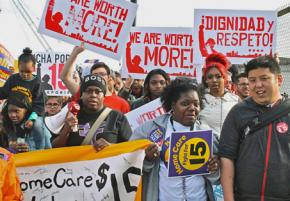Disrupting the low-wage status quo
looks ahead to today's "Day of Disruption" by low-wage workers.
LOW-WAGE workers and their supporters in some 340 cities plan to take part in protests, civil disobedience and, in some places, strikes on November 29 to raise the demand for a $15 an hour minimum wage and a union--marking the fourth anniversary of the Fight for 15 campaign.
Low-wage workers in retail, fast food and health care, among others, are joining the "Day of Disruption." In many cities, Fight for 15 protests will gather at McDonald's stores--a longtime target of the movement for the restaurant chain's refusal to pay more than the bare minimum or less.
This year, the Fight for 15 is emphasizing living wages and a union for airport workers. Cabin cleaners, baggage handlers, janitors and wheelchair attendants at 19 airports are joining fast-food and other airport workers who are striking in order highlight the deterioration of jobs that were once overwhelmingly union and provided living wages.
Today, some 42 percent of airport workers live below the poverty line, and four out of 10 admit they go hungry or skip a meal, according to a survey by the Service Employees International Union (SEIU). This while airline carriers' profits continued during the industry's several years' long profit boom.

In Chicago, some 500 workers at O'Hare International Airport who are organizing with SEIU, but aren't yet in the union, voted to strike. They originally planned to go out during busy Thanksgiving weekend, but rescheduled for November 29.
Kisha Rivera, a 41-year-old mother of four, tries to feed her family on the $10.50 an hour she gets working full-time as a cabin cleaner for airport subcontractor Scrub. With that pitiful low wage, she gets neither health benefits nor paid sick days, and relies on public assistance to make ends meet.
But these aren't her only concerns--she says that she and her co-workers often aren't properly trained or equipped for the job they do. "We are sick of talking, we are sick of being retaliated against, and we are ready to take action," Rivera told reporters at a press conference in mid-November.
In many places, protesters plan to take up other issues beside wages that affect low-wage workers--like police racism and brutality, sexual harassment on the job, and the threat of deportations for undocumented workers.
These demands are critical as activists seek to take up issues that potentially divide and weaken our side--and they are even more important as we all look down the barrel of a Donald Trump presidency.
Buoyed by Trump's win and fantasizing that they have a mandate, Republicans are preparing their pro-corporate wish lists of legislation.
Among the demands that Republicans will likely take up is reversing the Obama's executive order raising the minimum wage for federal contractors to $10.10 an hour. They see even this modest increase as a threat to corporate profitability. The federal minimum wage is still just $7.25 an hour.
Congressional Republicans want to put unions themselves on the chopping block as they plan for national anti-union "right-to-work" legislation. If they can't pass something national, there are officials waiting in the wings to push through right-to-laws legislation in states like Missouri.
With the promise of so many battles on the horizon, workers have a fight on their hands--and a reinvigorated Fight for 15 movement is a good place to start. Because if there's anything we should know about Donald Trump, his priority is the corporate bottom line--and he's not going to give workers anything without a fight to make him.
WHEN THE campaign began four years ago, the $15-an-hour minimum wage was derided for aiming too high and supposedly "endangering" companies who would go out of business if they were forced to pay a living wage.
But as low-wage workers stepped out of the shadows and into the streets, telling their stories about what it's like to live on a minimum wage, they found out there were many more like them facing the same experiences who wanted to fight--and still more who wanted to stand beside them in their struggle.
The movement turned $15 an hour into a popular--and achievable--demand.
But as Election 2016 wound down into its final months, this got harder and harder to remember. The minimum wage was rarely mentioned by either Clinton or Trump--rather than raise expectations about what kind of living wage people should expect, the Democratic nominee lowered the bar.
Bernie Sanders had brought the Fight for 15 demand into the Democratic primaries, but Clinton said then that she preferred a much slower, more incremental approach. She tried to make Sanders' plan look like a pipe dream.
Clinton never actually supported a $15 an hour minimum wage--something she made clear to Corporate America, while trying to pretend that she was an ally in the struggle.
According to e-mails between campaign staffers exposed by WikiLeaks, the Clinton campaign struggled to find ways to "support" the movement without supporting a $15 minimum wage. "Can we do something creative to support efforts without coming out for a number?" asked a senior advisor.
Despite the low bar set by the presidential election, millions of people can still be rallied behind something more.
During the November election, minimum wage initiatives on the ballot in several states showed that demands for higher minimum wages are still popular among working people. Voters in Colorado, Arizona and Maine approved minimum-wage increases to $12 an hour by 2020--not what activists are fighting for, but a step in that direction. Washington state increased the minimum wage statewide to $13.50 an hour by 2020.
One of the most important lessons coming out of this election comes from the low-wage workers who protested for $15 and a union well before the presidential race stole the national spotlight: Corporate America can afford to pay workers at least $15 an hour--but we have to build a movement strong enough to make them do it.


